Manual fare
HELP FB or H/FB
The likely situations in which you will need to enter fares manually are:
-
Consolidated/negotiated fares
-
Fares marked with an X in a fare display (for example, round the world)
-
Re-routing fares
-
Fares obtained from airline GIS pages (for example, air passes)
-
Group fares
There are three basic steps in the process:
-
Create the manual fare build - FBC
-
Update/amend the data - FBU
-
File the manual fare - FBF
Once a booking file has been created or retrieved, a Fare Build screen must be created to construct a manual fare.
Refer to the following booking file:
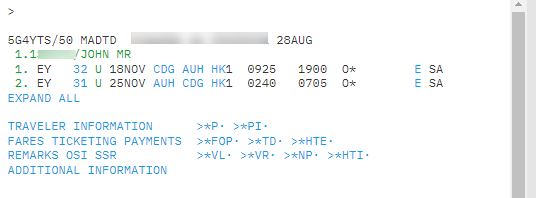
The following steps describe how to create a manual fare in the booking file.
Step 1: Create the fare build
It is good practice to get accurate tax information. You can obtain tax information directly from the airline. You can also enter FQTE-00 to get the tax without the fare on the itinerary, which makes it easier to enter the tax information.

Enter: FBC (Fare Build Create)
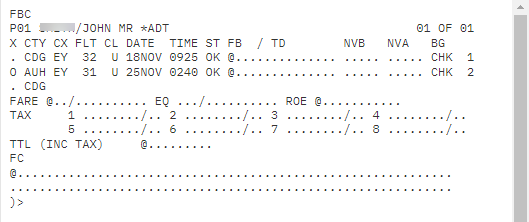
Note: This is not a fill-in format screen. All the entries are made at the bottom of the screen and are then placed automatically by Travelport+ into the appropriate place on the Fare Build screen.
The creation of a Fare Build screen assumes all passengers and all segments are to be associated with the same fare. If there are different passenger types, or if the fare is only required for certain segments, the Fare Build screen can be created by passenger and/or segment.
Refer to the following formats:
|
Format |
Explanation |
|---|---|
|
FBCP5 |
Fare Build screen for passenger 5 only |
|
FBCP3-5 |
Fare Build screen for passengers 3 through to 5 |
|
FBCS2-3 |
Fare Build screen for segments 2 and (through to) 3 |
|
FBCP2/S2-3 |
Fare Build screen for passenger 2, segments 2 and 3 |
You may create a Fare Build screen for a specific passenger description code.
|
Format |
Explanation |
|---|---|
|
FBCP5*C08 |
Fare Build screen for passenger 5, description as a child aged 8 years. |
|
FBCP2*C08.1 |
Fare Build screen for passenger 2, description as child aged 8 years, plus passenger 1 adult. |
If no passenger description codes are used, the system will default to adult or infant, if the infant has been specified in the name field.
A plating carrier is mandatory and can be added to the beginning or the end of the FBC entry (for example, FBCCMH or FBCP2-3/CAA).
To create the Fare Build screen, enter: FBCCEY
|
Format |
Description |
|---|---|
|
FBC |
Fare Build Create |
|
C |
Plating Carrier |
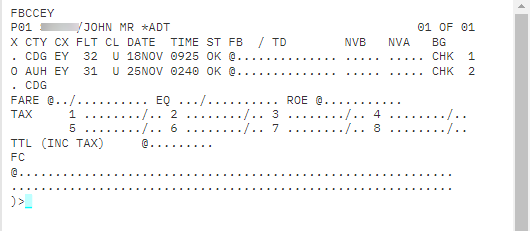
Note: The @ symbol indicates a mandatory field.
Fare Build screen fields with descriptions and entry examples:
|
Field |
Mandatory? |
Description |
|---|---|---|
|
FB |
YES |
Fare basis code for each segment |
|
FARE |
YES |
The total base fare of the ticket (local currency, of the country of origin) |
|
TTL |
YES |
Total fare including taxes |
|
FC |
YES |
Fare construction (NUCs) |
|
ROE |
YES |
Rate of exchange (NUC to local currency) |
|
TD |
NO |
Ticket designator (identifies special/discounted fares, for example, CH25 identifies a child discount of 25%) |
|
BG |
YES |
Baggage allowance for each segment |
|
NVB |
NO |
Not valid before date |
|
NVA |
NO |
Not valid after date |
|
EQ |
NO |
Equivalent fare (fares issued in a different currency) |
|
TAX |
NO |
Taxes – enter if applicable |
Except for the ROE field, if any mandatory fields are omitted, you will not be able to end the booking file. All other fields are optional and may be completed as required by the IATA ticketing standards.
Step 2: Enter fare information
You must complete the Fare Build screen using fare build update entries, which you can enter one at a time or as a string linked by the + key.
The entry to update a fare build is: FBU (Fare Build Update)
An example of updating a fare basis is FBUFB/UEYTEST1. This update will apply to all segments.
|
Format |
Description |
|---|---|
|
FBU |
Fare Build Update |
|
FB |
Code for the item to be updated (fare basis) |
|
/ |
Separator |
|
UEYTEST1 |
Information to be entered (the fare basis code) |

An example of updating a ticket designator is FBUTD/CH25. This update will apply to all segments.
|
Format |
Description |
|---|---|
|
FBU |
Fare Build Update |
|
TD |
Code for the item to be updated (fare basis) |
|
/ |
Separator |
|
CH25 |
Information to be entered (ticket designator) |

Note: A ticket designator may be added as a ticketing modifier using TMU entries. See the Issue Documents module for further details.
The system clears the screen when making this response, so you must make a display entry if you want to recall the Fare Build Update screen.
To redisplay the Fare Build screen, enter: *FB
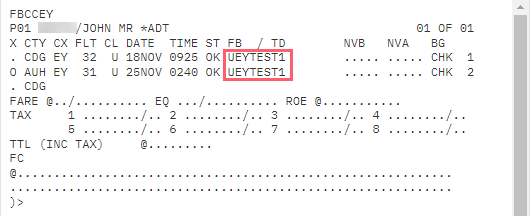
The following table provides examples of adding/updating the mandatory fields for this booking file. Entries can be made in any order.
|
Format |
Description |
|---|---|
|
FBUFB/UEYTEST1 |
Fare basis for all segments |
|
FBUTD/CH25 |
Ticket designator for all segments |
|
FBUNVB1/02SEP21+NVA1/02SEP21 |
Segment one Not valid before and not valid after date Note: Year is mandatory with dates. |
|
FBUNVA/02SEP21 |
Not valid after date all segments |
|
FBUBG/1PC or FBUBG/30K |
Baggage allowance as per requirement |
|
FBUFARE/EUR392.00 |
Fare amount |
|
FBUROE/0.845527 |
IATA rate of exchange |
|
FBUFC/PAR EY AUH 280.88 EY LON Q27.63 151.98 Q PARLON3.00NUC463.49 |
Fare construction As a best practice, add FC after taxes. |
|
FBUTTL/ |
Total fare (including taxes) calculated automatically |
All the applicable taxes need to be updated. Here are some examples of adding taxes.
|
Format |
Description |
|---|---|
|
FBUTAX1/20.07FR |
Update one tax |
|
FBUTAX1/20.07FR+TAX2/4.51IZ+TAX3/29.62QX |
Update multiple taxes |
|
FBUTAX1/20.07FR+TAX2/4.51IZ+TAX3/29.62QX+ |
Update multiple taxes |
|
*FBTAX |
Display all tax screen |
Note: All entries can be segment-related and combined with an end item (+).
Example:
FBUFARE/EUR392.00+TAX1/20.07FR+TAX2/4.51IZ+TAX3/29.62QX+TAX4/3.00O4+TAX5/16.81AE+TAX6/7.85F6+TAX7/1.12TP+TAX8/246.90YQ+BG/23K+FB/UEYTEST1

You may add/update a maximum of 20 taxes.
You can also add endorsements as part of the fare build process, although not part of the FB screen. You must enter them separately from other FBU entries. More commonly, you would add the endorsement as a ticket remark (TMU).
Example: FBUEB/NO REFUNDS NO CHANGES

Example after redisplaying with *FB:
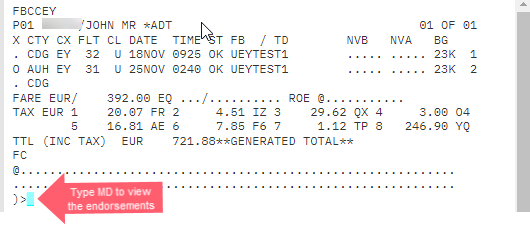
Enter MD to move down.
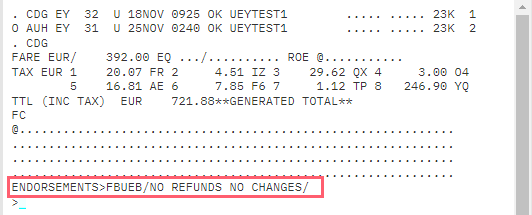
The FB, NVB, NVA, and BG entries can all be segment related.
Format example for baggage allowance: FBUBG1/23K+BG2/2PC
Explanation: Baggage is 23K for segment 1, and 2PC for segment 2
Example response for entry *FB:
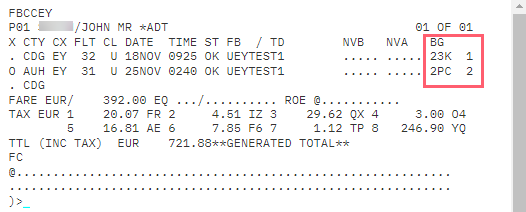
Note: The line number used in the segment related entries is the number shown on the far right of the Fare Build screen, which is not necessarily the segment number in the itinerary. The Fare Build screen ignores any ARNK segments for numbering purposes.
FBUBG/NIL allows you to add nil value for baggage allowance.
X - Transit / Stopover
To specify segment 3 with no stopover - FBUX3/X
To specify segment 1 and 3 with stopover - FBUX1.3/O
Passenger facility charge
When completing the Fare Build screen, you will need to pay attention to the Passenger Facility Charge if you are creating a manual fare for North American itineraries.
The PFC was introduced by the USA Government in 1992 and allows some airports to collect a user fee from the passenger to fund airport development. In addition to the tax entry for the PFC amount (code XF), it is necessary to tell the system to which airports it applies.
The entry to add this information is in the same format, but it must be made on its own; it cannot be made as part of an FBU string.
Example: FBUPFC/JFK4.5
|
Format |
Description |
|---|---|
|
FBU |
Fare Build Update |
|
PFC |
PFC |
|
/ |
Separator |
|
JFK4.5 |
Information to be entered (airport code to which tax applies – JFK, and amount in USD4.50) |

The system is not able to validate the city and value or that the PFC entry matches the XF tax entry.
It is therefore advisable to consult the tax pages for the current amount to be charged for each airport using the entry: FTAX*PFC–XXX (where XXX= three-letter airport code).
A maximum of four PFCs is allowed. When more than one PFC is to be added to the ticket, all PFCs must be input as a single entry, using the USD amount, no matter where the ticket is being sold.
Example: FBUPFC/JFK4.5BUF3DEN5PHL4.5
The PFC entry will appear on the Fare Build screen in the Fare Construction line but can only be entered after completion of the fare construction and ROE entries.
Below is an example in a completed Fare Build (*FB) screen:
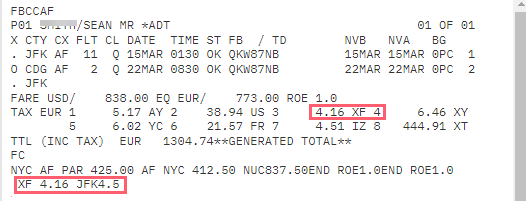
Note: The PFC (XF) is also repeated at the end of the Fare Construction line.
To display all the taxes entered, enter: *FBTAX

Enter *FB to return to the main Fare Build screen.
Flight segment tax (US domestic journeys only)
US domestic journeys incur a tax called a segment tax with the code ZP. In a similar way to the PFC tax, an additional entry must be made in the fare build before it can be filed when a ZP tax occurs.
Example: FBUTB1/ZPJFK3
Note: TTL will be added automatically by the system once fare and taxes have been input.
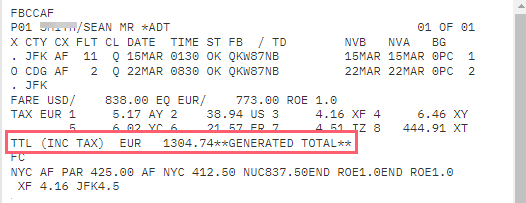
Enter FBUTTL/ If you have made an amendment to the fare or taxes and need to recalculate the total.
Note: The entry FBUTTL/ should be your last entry after updating all the required elements in the Fare Build screen prior to filing the fare.
Step 3: File the manual fare build
When you have completed the Fare Build screen, file it to save your work.
The basic entry to file a fare is: FBF (Fare Build File)
However, there are several format options for filing a fare:
|
Format |
Description |
|---|---|
|
FBF |
File current passenger screen. |
|
FBFALL |
File the current passenger screen and the same details for all remaining passengers. (See next section). |
|
FBFCUA |
File current passenger screen with plating carrier UA (if not used in FBC entry) |
|
FBFALL/CQF |
File current and all remaining passengers with plating carrier QF. |

To save the fare data, end the booking file in the usual manner.
Display the manual filed fare
Terminal view
To redisplay the filed fare, enter *FF

or press *FF in the FARES TICKETING PAYMENT section of the PNR
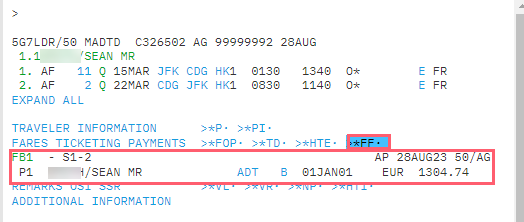
To display all filed fare details, enter *FF1 or press the green FB1 you previously displayed with *FF.

Graphical view
You can also display the manually created fare in the graphical view.
Select the Booked Travel section. On the left side of the screen, you will see the total price of the fare. On the right side, you will see the amount of the base fare and the total taxes.
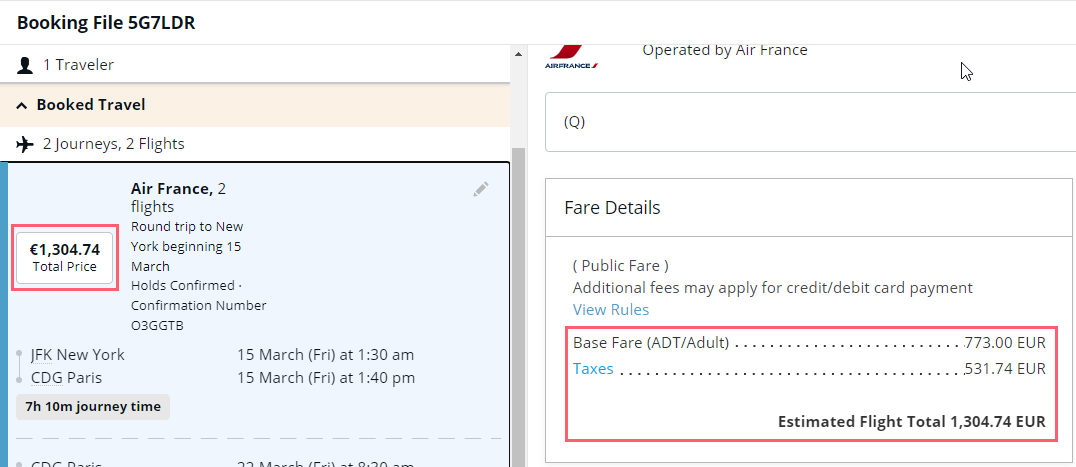
Select Taxes to view a breakdown of the taxes:
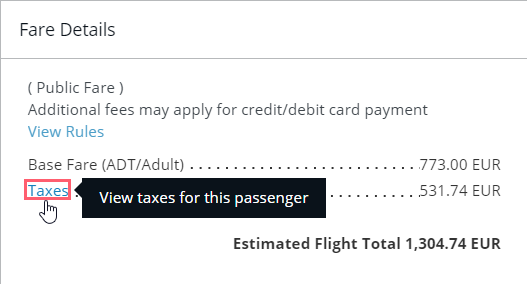
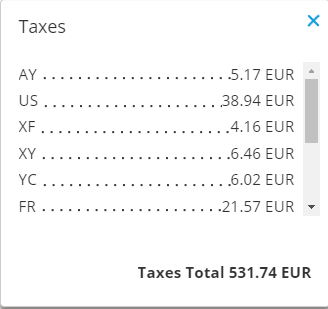
Multiple passengers/different passenger descriptions
When a booking file is created for more than one passenger, it is important to ascertain what type of passenger description they have, such as a child, prior to proceeding to a manual fare build.
Here is a booking file with three adult customers:
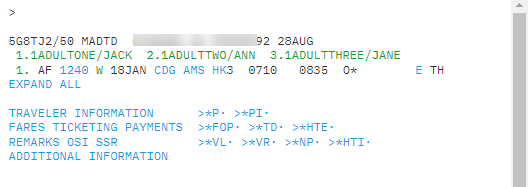
Enter FBCCAF to create a fare build.
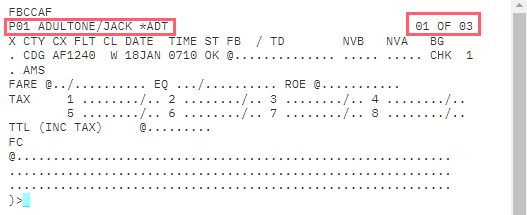
The system creates a Fare Build screen for each passenger. In this example, a top line shows P01 (Passenger 1) and 01 of 03, indicating the first of three screens.
Once you’ve completed the first screen and filed (FBF), the next Fare Build screen will appear automatically for passenger 2.
At this point, you can enter FBFALL to file all remaining passengers with identical fare information.
|
Format |
Description |
|---|---|
|
FBF |
Fare Build File |
|
ALL |
All passengers |

Similar logic applies when the passenger types are different. Using the previous example, let us assume that passenger 3 is a 7-year-old child. As there are two types of passengers, you must complete at least two Fare Build screens.
You would think the entry to arrange Fare Build screens would be: FBCP1.2.3*C07
However, the system works logically and would show the screen for passenger 1 first.
After completing the screen, you could not use entry FBFALL because passenger 3, a child, requires different manual fare build details than those used for the other two passengers who are adults.
You need to complete the second screen for the second adult, and finally complete the third screen for the child.
Therefore, a more effective way to complete this scenario is to start the entry with the smallest group of passengers, in this case, the child passenger.
Enter: FBCCAF/P3*C07.1.2
The Fare Build screen for the child displays first:
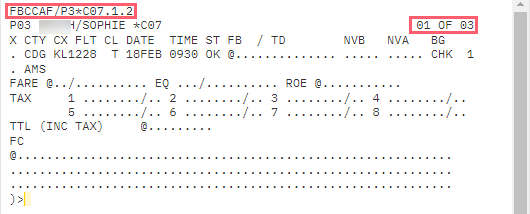
Complete this screen and file, using the entry FBF.
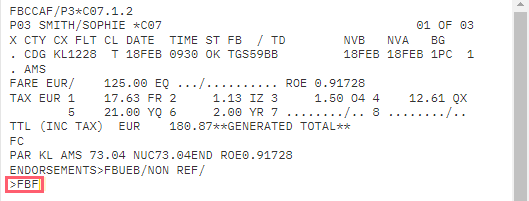
The child’s fare will be filed, and the first adult's (passenger 1) screen will appear:
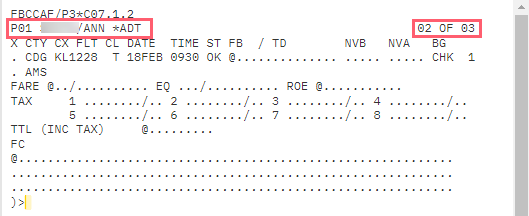
After completing the first adult screen, you may use the entry FBFALL to file the same Fare Build information for all remaining passengers.
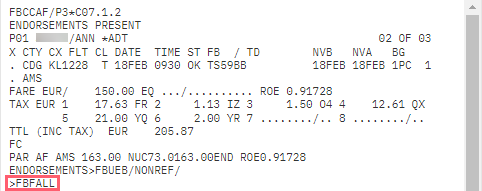
Using this process, all three screens will be stored under one filed fare in just two, rather than three, transactions.

Note: In some cases, for instance, Net Remit tickets, separate filed fares must be created because separate ticket modifiers are added for each passenger description.
Example: FBCP1.2
This entry presents a Fare Build screen for both adults, known as filed fare 1, which can then be updated and filed.
Example: FBCP3*C07
This entry presents a Fare Build screen for the child, filed fare 2, which can then be updated and filed.